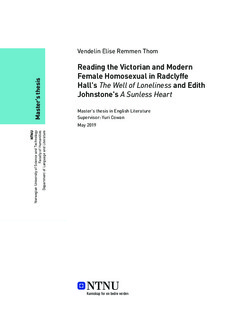| dc.contributor.advisor | Cowan, Yuri | |
| dc.contributor.author | Thom, Vendelin Elise Remmen | |
| dc.date.accessioned | 2019-08-23T14:04:11Z | |
| dc.date.available | 2019-08-23T14:04:11Z | |
| dc.date.issued | 2019 | |
| dc.identifier.uri | http://hdl.handle.net/11250/2610022 | |
| dc.description.abstract | Denne masteroppgaven utforsker representasjonen og fremstillingen av kvinnelig homoseksualitet i litteratur fra sent 1800-tall og tidlig 1900-tall. Ved å analysere og diskutere Radclyffe Halls The Well of Loneliness og Edith Johnstones A Sunless Heart i lys av bokanmeldelser fra samtiden, forsøker oppgaven å forstå hvordan kvinnelige homofile bånd er konstruert, og videre oppfattet av samtidslesere. Oppgaven vil først gi en kort historisk innføring for å forstå de sosiale og kulturelle holdningene til kvinnelig homofili og kvinners rolle i samfunnet generelt. Videre vil oppgaven etablere et rammeverk gjennom Wolfgang Isers teori om «tomme plasser» og leserens betydning i aktualiseringen av teksten i tilknytning til Eve Kosofsky Sedgwicks «episemologi av skapet,» for å forstå hvordan kvinnelige homofile bånd er konstruert i romanene. Deretter vil oppgaven analysere og diskutere The Well of Loneliness (1928) i lys av det etablerte rammeverket for å forstå hvordan lesere kan tolke naturen av romanens kvinnelige homofile bånd ulikt. Fordi romanen illustrerer kvinnelig homoseksualitet på en eksplisitt måte er formålet her å forstå hvordan samfunnets uvitenhet om romantiske og intime forhold mellom kvinner kan påvirke hvordan ulike lesere oppfatter dem. Ideen er her at en heterofil leser vil danne ulike bilder av disse forholdene enn en homofil leser vil, basert på lesernes tidligere erfaringer og kunnskap om temaet. Til slutt vil oppgaven gi en lignende analyse og diskusjon av A Sunless Heart (1894). Denne romanen illustrerer kvinnelig homofili på en mer implisitt måte enn den andre, og formålet er derfor å utforske hvordan vennskap brukes som en metafor eller som et «skap» for å skjule den intime siden av kvinnelige homofile bånd. | |
| dc.description.abstract | This master’s thesis seeks to explore the representation and depiction of female homosexuality in late nineteenth and early twentieth century literature. By analysing and discussing Radclyffe Hall’s The Well of Loneliness and Edith Johnstone’s A Sunless Heart through contemporary reviews, it attempts to understand how female homosexual bonds are constructed, and further perceived by contemporary readers. The thesis will first provide a brief historical background to understand the social and cultural attitudes towards female homosexuality and women’s role in society in general. Secondly, the thesis will establish a framework through Wolfgang Iser’s theory of “gaps” and the reader’s importance in the actualisation of the text in relation to Eve Kosofsky Sedgwick’s “epistemology of the closet,” to understand how the female homosexual bonds are constructed in the novels. Thereafter, this thesis will analyse and discuss The Well of Loneliness (1928) through this framework to understand how readers could interpret the nature of the bonds within the novel different from one another. Since this novel illustrates female homosexuality in an explicit manner, the purpose here is to explore how society’s ignorance of romantic relations between women could influence how different readers perceive them. The idea here is that a heterosexual reader would create different images of the female relations than a homosexual reader, based on their prior knowledge and experiences with the subject. Lastly, the thesis will provide a similar analysis and discussion of A Sunless Heart (1894). This novel illustrates female homosexuality more implicitly than the latter and the purpose is thus to explore how friendship is used as a metaphor or “closet” to hide the intimate side of female homosexual bonds. | |
| dc.language | eng | |
| dc.publisher | NTNU | |
| dc.title | Reading the Victorian and Modern Female Homosexual in Radcllyffe Hall's The Well of Loneliness and Edith Johnstone’s A Sunless Heart | |
| dc.type | Master thesis | |
